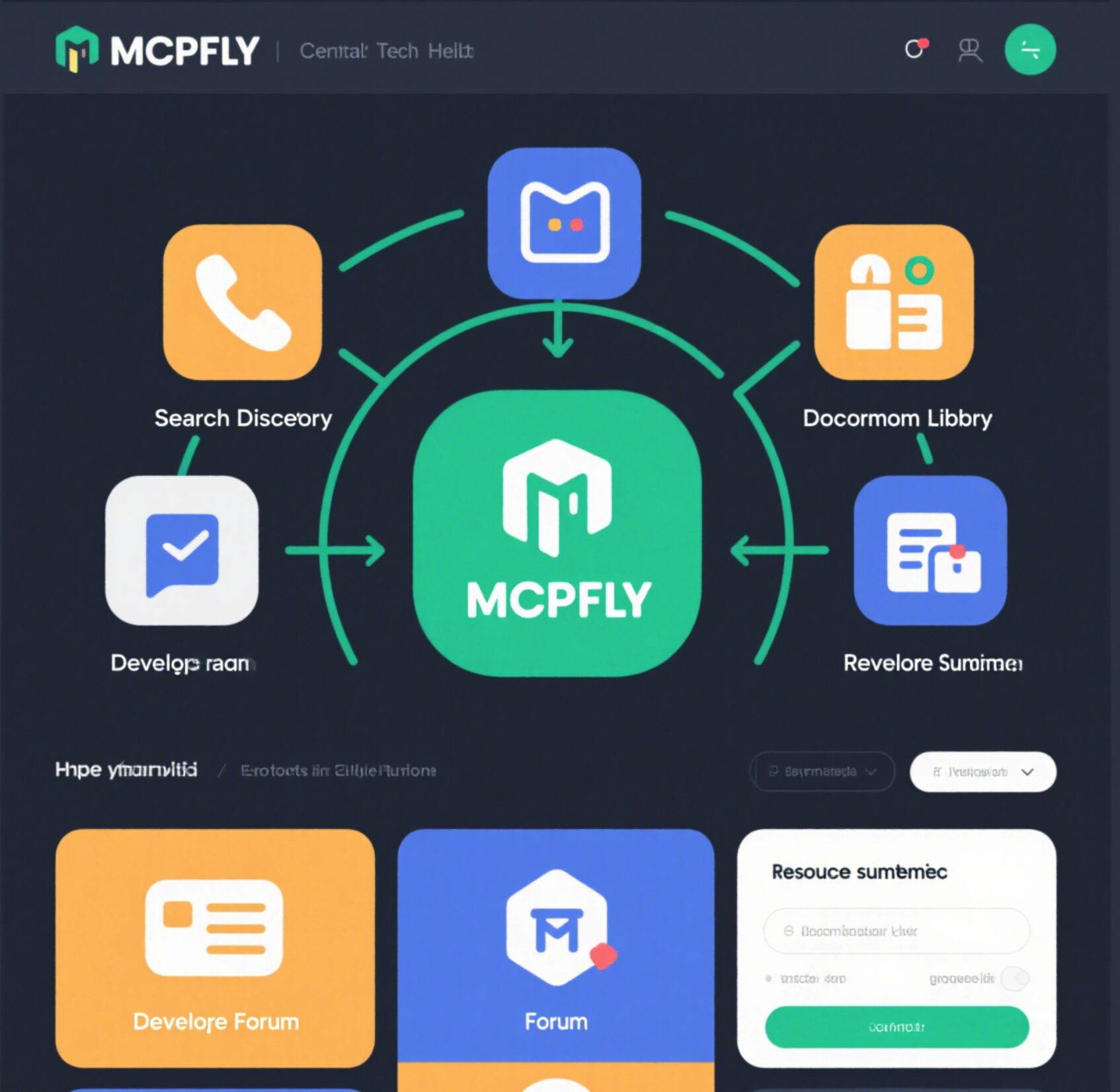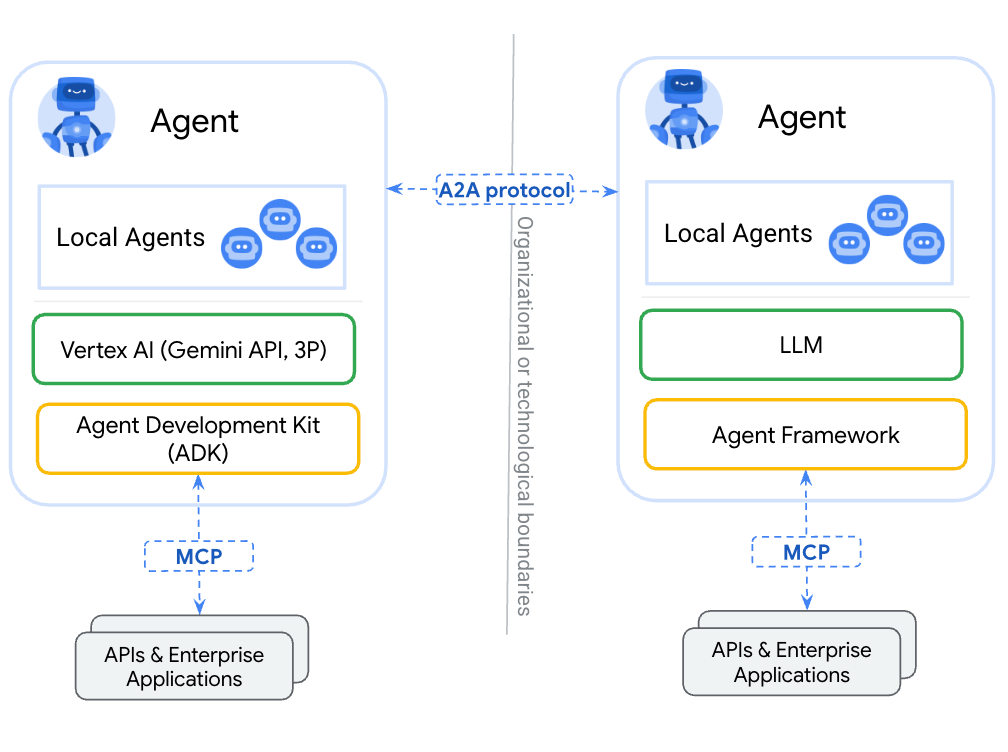Making AI Agents Work Together: Understanding Google's A2A Protocol
Introduction
Artificial intelligence (AI) is changing everything. We see specialized AI agents popping up everywhere, designed for specific jobs. Imagine a research project: one AI agent finds research papers, another analyzes data, and a third writes a draft report. Each agent is smart on its own, but if they can't talk to each other, they're like musicians playing alone in soundproof rooms – skilled, but unable to create a symphony together.
Right now, many AI agents work in isolation. This creates problems and limits what AI can truly achieve. Google's Agent-to-Agent (A2A) protocol aims to fix this. It's like creating a standard language or a "neural network" that connects different agents, allowing them to work together effectively and combine their intelligence.
The Challenge: Why We Need Agent Collaboration
Many current AI agents are experts in their own field, but they weren't built to easily chat with other agents. This causes real problems:
- Broken Workflows: If agents handling different steps in a process can't communicate automatically, humans often have to step in, or complex custom connections must be built. This slows things down and increases the chance of mistakes. Think of a factory: if the design AI can't easily send plans to the production AI, manufacturing gets delayed.
- Delayed Information & Bad Decisions: Things change fast. If a market analysis AI spots a trend but can't quickly tell the marketing strategy AI, the company might miss out or react too slowly to risks. Lack of real-time sharing hurts responsiveness.
- Wasted Effort & Repeated Work: Without easy ways to collaborate, different agents might end up doing the same job. For example, multiple departments might have agents analyzing customer data separately, wasting computing power and development time.
These issues show why we urgently need a standard, open way for AI agents to talk to each other.
Introducing A2A: A Common Language for Agents
The A2A protocol was created to solve these communication problems. It doesn't try to change what agents do, but instead gives them a standard set of rules for "handshakes" and "conversations." This lets agents built by different teams or companies interact using a shared language.
Google Cloud and partners are working to make A2A a widely used standard. It uses a familiar client-server approach, but agents can switch roles – sometimes asking for help (client), sometimes providing a service (server).
How A2A Works: Key Ideas
A2A provides a structured way for agents to interact:
-
The Players (Actors):
- User: The person or service wanting something done.
- Client: The agent acting on the user's behalf, requesting help from another agent.
- Remote Agent (Server): The agent providing the service or performing the task. It's treated as a "black box" – the client doesn't need to know how it works inside.
-
Finding Agents (Discovery): How does a client find the right agent for a job? Agents publish an Agent Card. Think of it like a business card or online profile in a standard JSON format. It describes:
- What the agent is called and what it does.
- Its "skills" or capabilities.
- The types of data it can handle (text, images, etc.).
- How to connect to it (URL).
- Security requirements (how to authenticate).
Clients can look up these cards (e.g., at a standard web address like
/.well-known/agent.jsonor in a private registry) to find suitable partners.
-
Talking to Agents (Transport & Format):
- A2A uses standard web technology: HTTP for communication.
- Messages are formatted using JSON-RPC 2.0, a simple standard for remote procedure calls.
-
Handling Tasks (Core Objects): The main goal is completing Tasks.
- A Task represents the job to be done. It has a unique ID and tracks its status (like
submitted,working,input-required,completed,failed,canceled). - Tasks can be quick or long-running. For long tasks, the client can either ask for updates periodically (polling) or use Server-Sent Events (SSE) to get real-time status updates streamed from the server agent.
- Messages are used for communication within a task. They contain instructions, context, status updates, or questions. A message has a
role(useroragent) and contains one or moreParts. - Parts are the actual content pieces within a Message or an Artifact. They can be text (
TextPart), files (FilePart- with data encoded or via a URI), or structured data (DataPart). This allows agents to exchange various kinds of information. - Artifacts are the final results produced by the agent for a task (e.g., a generated report, an image, structured data). They are immutable and can also contain multiple Parts.
- A Task represents the job to be done. It has a unique ID and tracks its status (like
-
Keeping it Secure (Authentication & Authorization):
- A2A treats agents like enterprise applications. Security is built-in.
- It follows standard practices like OpenAPI's Authentication specification.
- Authentication details (like tokens) are not sent inside the A2A messages themselves but in standard HTTP headers.
- The Agent Card lists the required authentication methods (e.g., OAuth2, Bearer tokens).
-
Staying Updated (Push Notifications): For very long tasks, even if the client disconnects, the server agent can send a notification to a separate Push Notification Service when the task state changes (if configured). This service (which might not be the client itself) handles delivering the notification securely.
A2A vs. MCP: Tools vs. Agents
It's important to understand how A2A relates to another emerging standard: Model Context Protocol (MCP). They solve different, but complementary, problems.
-
MCP (Model Context Protocol): Focuses on connecting AI models (like LLMs) or agents to Tools. Tools are like functions or APIs with structured inputs and outputs (e.g., a weather API, a calculator function, a database query). MCP standardizes how agents call these tools and get structured data back. Think of MCP as the standard way for an agent to use a specific utility.
-
A2A (Agent-to-Agent Protocol): Focuses on Agent-to-Agent collaboration at a higher, application level. It's about agents working together to achieve a broader goal, exchanging information in their natural ways (text, files, instructions), often involving back-and-forth conversation and complex, evolving tasks. Think of A2A as the standard way for expert agents to cooperate.
Analogy: The Auto Repair Shop
- Imagine AI agents working as mechanics in a repair shop.
- MCP would be the protocol they use to operate their specific tools: "activate wrench," "read diagnostic code," "lift platform." These tools have clear inputs and outputs.
- A2A would be the protocol the mechanics use to talk to the customer ("Describe the noise your car is making.") or to each other ("I need the specs for this engine part.") or to the parts supplier agent ("Order part #XYZ."). This involves conversation, planning, and achieving a larger goal (fixing the car).
How they work together: A2A and MCP are complementary. An application might use MCP to give its agent access to various tools and data sources. That same application could use A2A to allow its agent to collaborate with other specialized, independent agents. The A2A documentation even suggests that an A2A-capable agent could be represented as a resource discoverable via MCP, using its Agent Card.
In short: Use MCP for tools, use A2A for collaborating agents.
The A2A Workflow in Action
Here’s how a typical collaboration using A2A might look:
- Discovery & Matching: The client agent needs a task done. It looks for server agents capable of doing it, perhaps by searching a registry or checking known agents' Agent Cards to understand their skills and requirements.
- Task Initiation: Once a suitable agent is found, the client sends a task request (e.g., using the
tasks/sendmethod, ortasks/sendSubscribeif it wants streaming updates). This request includes a unique task ID and a Message containing the initial instruction or data (as Parts). - Execution & Status Updates: The server agent accepts the task and starts working (status becomes
working).- If using SSE, the server pushes TaskStatusUpdateEvents (e.g., status changes, messages like "Working on step 2") and TaskArtifactUpdateEvents (streaming parts of the result) to the client.
- If not using SSE, the client can periodically call
tasks/getto check the status and retrieve results.
- Interaction (If Needed): If the server agent needs more information, it sets the task status to
input-requiredand sends a Message asking the client for input (e.g., "Please choose Option A or B"). The client then sends anothertasks/sendmessage with the same task ID, providing the requested information. - Completion & Results: When finished, the server agent sets the status to
completed(orfailed/canceled). The final results are packaged as Artifacts and sent to the client (either in the final SSE message, the response totasks/send, or retrieved viatasks/get).
Why A2A Matters: Core Principles
A2A is built on five key ideas:
- Opaque Execution: Agents collaborate without needing to share their internal workings, plans, or private tools. They interact based on inputs and outputs, respecting each agent's autonomy.
- Simple (Reuse Existing Standards): A2A uses common web technologies (HTTP, JSON-RPC, SSE) that developers already know, making it easier to adopt.
- Enterprise Ready: It includes built-in considerations for security (authentication, authorization), privacy, tracing, and monitoring, making it suitable for business use.
- Async First: Designed to handle tasks that take a long time, including those requiring human input, through polling, streaming (SSE), and push notifications.
- Modality Agnostic: Agents can exchange information in various formats (text, audio, video, forms, files, structured data), not just text.
Real-World Examples of A2A
A2A can enable powerful new applications:
- Smarter Customer Service: A customer service agent could use A2A to talk directly to order management, logistics, or technical support agents to get real-time answers or seamlessly hand off complex issues without the customer noticing the switch.
- Better Supply Chains: Sales forecast agents, inventory agents, and logistics agents could use A2A to share data and coordinate actions automatically, making the supply chain faster and more responsive.
- Automated Workflows: A new employee onboarding process could involve an HR agent using A2A to trigger an IT agent (to create accounts) and a finance agent (to set up payroll), automating the entire sequence.
- Collaborative Content Creation: Imagine a network of agents – one finds trends, one writes in a certain style, one creates images. Using A2A, they could work together to produce customized content automatically.
Ecosystem and Resources
A2A is gaining traction, with support from companies like Google Cloud, Atlassian, Salesforce, SAP, Accenture, and Deloitte. This backing helps build a strong ecosystem. Resources for developers include:
- Detailed technical specifications.
- Sample code and libraries.
- An open community for discussion and contribution.
The Future: Connected Intelligence
A2A provides a blueprint for how AI agents can work together effectively. It's more than just a technical standard; it could become the foundation for future AI ecosystems where collaboration is key. As businesses rely more on AI agents, the ability for these agents to work together seamlessly across different systems and organizations will be crucial.
With its open, secure, and flexible design, A2A has the potential to unlock:
- More Adaptive Systems: Agent teams that can dynamically find partners and adjust how they collaborate.
- Emergent Intelligence: Complex, intelligent group behaviors arising from simple agent interactions defined by A2A.
- New Intelligent Services: Innovative services created by combining the capabilities of specialized agents across different platforms.
The development of A2A pushes AI towards more distributed and collaborative intelligence, helping build a smarter, more efficient, and interconnected world.


